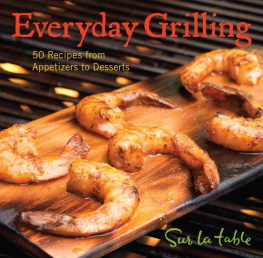The Little Inihaw Book
Gene Gonzalez
Center for Asian Culinary Studies
Copyright GENE GONZALEZ, 2015
All rights reserved. No part of this book may be reproduced in any form or
by any means without the written permission of the copyright owner and
the publisher.
Published and exclusively distributed by
ANVIL PUBLISHING INC.
7th Floor Quad Alpha Centrum Building
125 Pioneer Street
Mandaluyong City 1550 Philippines
Telephones: (632) 477-4752, 477-4755 to 57
Locals 815 and 817
Fax: (632) 747-1622
www.anvilpublishing.com
Book design by ANI V. HABLAN (cover) and JOSHENE BERSALES (interior)
Food styling by NOVIA DAVID ZAPATA
Front cover photo by CROWN DOLOT
Photo of the author on the back cover by WENDY BASILIO
Illustrations by MOISES NICOLAS
ISBN 978-971-27-3191-4 (e-book)
Inihaw
I nihaw, sinugba, inasal, dinerang, intono or whatever Filipino regional term is used, grilling food over charcoal or fire is one of the most ancient methods of cooking in the Philippines and perhaps, the world. Barbecues and grilled foods are considered very healthy and contain less calories. Despite its simplicity, the flavor of grilled cuisine gets its character from so many factors in preparation such as the grilling medium, the grilling method, marinades, sauces and the side dishes that make inihaw an exciting and healthy facet of Philippine cuisine.
Introduction
W hen we talk of Filipino cuisine we mention favorite recipes such as adobo, sinigang or other titled dishes which revolve around the many cuisines of Luzon. Yet we forget that a great majority of recipes from the south, especially the Visayas and Mindanao, use the charcoal grilling method as their main cooking technique.
Barbecue, a term adopted from America, will surprise the neophyte in Philippine cuisine because it takes on the skewered Malay form which is sate but its marinades feature a mixture of Chinese, American and Malay influences.
My profound thanks to my three aprentices: Carla Ledesma, Jenny Tiano and Christine Paredes who encourage me to embark on this series of cookbooks so that the urban dweller may have quick and easy reference to homestyle cuisine at her or his fingertips.
This little book would also have not been possible without the support of Celia Padilla, Lasap: Pagkaing Pilipino manager, Marilyn Espino, Eugene Raymundo and Rizalina Chua of Caf Ysabel.
Contents
Sauces
Side dishes
10 tips
for a
good barbecue
- Do not use kerosene, gasoline, or other chemicals on your charcoal that would produce off-flavors.
- Control heat by gently spritzing water on hot coals.
- Use good quality charcoal: do not use resinous woods for cooking.
- Start your fire with gel fuel or denatured alcohol so your barbecue will not have undesirable flavors. You can also start some pieces of charcoal on your gas stove.
- Do not pour denatured alcohol directly on the fire or when fire has started. This could cause a fatal explosion.
- Avoid using newspapers for igniting your fire. Certain inks contain toxic substances.
- Follow correct marination time.
- Serve barbecue immediately. Do not overcook fish and seafood.
- Grease your grill or rack properly with clean edible oil or oil spray.
- Soak wooden skewers in water before using to prevent them from burning.
barbecued pork ribs
Ingredients
1 1/2 kgs. pork ribs, cut into 4 rib cuts, not to exceed 1 inch in thickness of meat and fat
MARINATE IN
1/2 tsp. nho-hiong or five-spice powder
1/2 cup 7-Up
1 tsp. garlic, crushed
6 tbsp. honey
2 tbsp. vinegar
1/2 tsp. pepper
1/2 tsp. chopped ginger
3 tbsp. soy paste
1/2 tsp. hoisin sauce
1/2 tsp. chili powder | Procedure
Marinate pork ribs for 24 hours. Grill over low or medium heat while basting with marinade. |

The Chef Says:
You can serve this dish with Kinilaw na Labanos to complement the smoky Oriental nuances of pork. |
barbecued tenderloin
Ingredients
1 kg. tenderloin
1 tbsp. Worcestershire sauce
dayap juice
1 tsp. minced garlic
1/2 tsp. pepper
1 tbsp. Japanese soy sauce
dash of sesame oil | Procedure
- Rub meat with marinade.
- Grill over low heat for 30 minutes while brushing on marinade.
|

The Chef Says:
This goes well with Inihaw na Mais, Ripe Tamarind sauce, the all-purpose Ihaw-ihaw sauce, Postreng Pimenton, Kinilaw na Pilipino. |
barbecued pork belly
Ingredients
2 kgs. pork liempo (pork belly)
2 tbsp. finely chopped garlic
1/2 cup vinegar
1 tbsp. cracked black peppercorns
1 tbsp. soy sauce
2 tbsp. 7-Up | Procedure
- Marinate pork for 24 hours.
- Braise in marinade for 15 minutes. Skin side on the bottom of the pan. Hang and dry pork for about 15 minutes.
- Roast over medium heat on a small spit with charcoal or place in an oven rotiserrie and roast until skin is crisp and crackling. Chop and serve.
|
|

The Chef Says:
You may use Postreng Talong, Cucumber Salad, and Sinamak or Lechon sauce as dip. |
grilled corn
Ingredients
yellow corn, husk and silk removed
1 dayap, cut into wedges
butter for brushing | Procedure
- Grill corn over hot charcoal until kernels are cooked and tender.
- While hot, squeeze some lime on corn and brush with butter.
|
 |

The Chef Says:
Make roasted corn salad by mixing roasted corn kernels with one recipe of Singkamas Relish and Wansuey. Add 1 tsp. of extra virgin olive oil, toss lightly and serve. |
grilled marlin with lemongrass
Ingredients
1/2 kg. marlin belly, cut into 1 1/2-inch cubes
1 lemongrass bulb, white part finely chopped
juice of 1 calamansi or dayap
1 tsp. white pepper
lemongrass | Procedure
- Marinate blue marlin for at least 34 hours.
- Skewer fish on very firm stalks of lemongrass then grill.
|

The Chef Says:
You can serve this with Green Tamarind sauce, Burong Kamias, Burong Mangga, Mangga sa Serbesa, or Kinilaw na Labanos. To add fragrance, squeeze on dayap, an aromatic Philippine green lemon which has a strong citrus flavor. |













